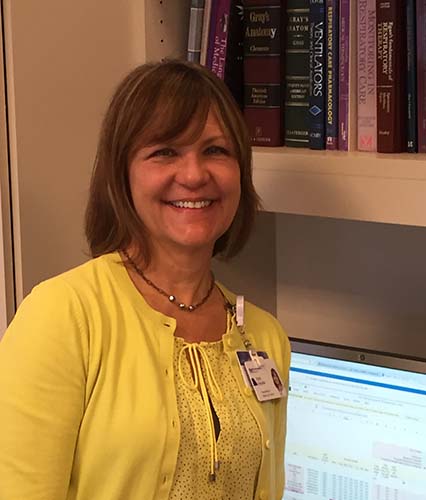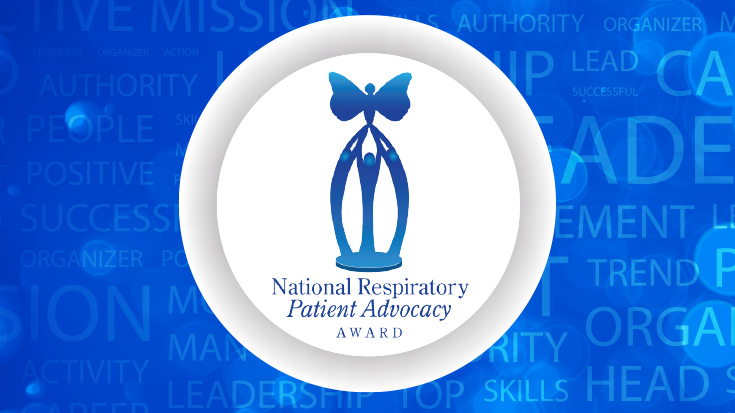Obstructive sleep apnea (OSA) is increasingly being recognized as a mortality risk in hospitals, but identifying patients who may have the condition and don’t know it — or have it and are not compliant with treatment — has been a challenge. At 395-bed Central Dupage Hospital in Winfield, IL, respiratory therapists are leading the charge to ensure OSA risk is addressed.
 AARC member Patti Dejuilio shares how her department leads the charge for OSA protocol.
AARC member Patti Dejuilio shares how her department leads the charge for OSA protocol.“Quality and safety began the journey to program implementation and forming a multidisciplinary task force,” says Patti DeJuilio, MS, RRT-ACCS, RRT-NPS, clinical director of respiratory care services and the Sleep Center. “The respiratory care department spearheaded and implemented the evaluation and subsequent monitoring and treatment of all patients entering the hospital system.”
Entire RT Staff Participates
It all began with a preop screening program aimed at identifying surgical patients who were at risk. Developed by a multidisciplinary team including the surgery team, respiratory care, pain management, and physicians, it was a good start, but DeJuilio and her colleagues quickly realized that it did little for patients after they left the PACU, not to mention those who were admitted to the facility outside of surgery. Nor did it help non-surgical patients who came into the facility with a current diagnosis of OSA.
“Not having screening tools in place and evidence-based practice guidelines to consistently follow every inpatient was a serious safety concern and could put patients and the institution at risk,” says the AARC member.
The team came up with a new protocol that covers all patients entering the hospital post-surgery, by direct admit, or after an emergency department visit. Since it is comprehensive, DeJuilio says all 70 of the RTs on her staff went through mandatory education on the protocol and capnography monitoring. “We recognized that any patient may be at risk for sleep apnea, therefore staff working in any area of the hospital needs to understand how to execute the protocol steps.”
Key Component
A key component of the protocol is the STOP BANG questionnaire, a simple tool that combines sleep-related questions with BMI, neck circumference, age, and gender to identify patients who may be at risk for OSA.
Patients who have already been diagnosed with OSA are encouraged to use their CPAP machines during hospitalization. Those who haven’t been diagnosed or who have been diagnosed but will not comply with CPAP treatment are monitored via capnography.
In a pre-implementation/post-implementation study of reports generated by the electronic medical record, DeJuilio and her colleagues found that the percentage of patients potentially at high risk for OSA who were treated or monitored jumped from 45% to 82%.
The program is extending beyond the hospital walls too. By placing heaters on all of their CPAP and BiPAP devices and offering patients a range of mask options, RTs are improving OSA treatment across the board. “Our goal is to keep them safe while in our care, and if we can affect what they do when they go home, we have done a great job!” says the manager.
Overcoming The “Alarms” Issue
The number of patients who require capnography monitoring generally ranges from two to 12 per night. Like many facilities that have implemented capnography, the alarms have been an issue, but now DeJuilio and her crew are coming up with a solution for that as well.
“When I presented capnography monitoring on the floors to our chief nursing officer, her first response was, ‘I am concerned about additional alarms when we have been working so hard to address alarm fatigue,’ ” says DeJuilio. She assured the CNO that an RT would be notified when a capnography alarm sounded, but at the same time knew that immediate response could be a problem in a hospital where RTs were spread out over such a large geographic area.
Luckily, the hospital’s contract for pulse oximetry and capnography disposable product use was up for review and revision, and she saw an opportunity to expand wireless monitoring along with other hardware upgrades to be put into place. For the past few months she and her colleagues have been working closely with their IT department to implement a strategy in which one RT per shift will carry an iPad with all of the capnography waveforms for all of the patients on capnography during that shift.
“They will be accountable for responding to patients that have issues and concerns regarding EtCO2 and for carrying out the OSA protocol,” she says. While she still has a few issues to work out, as of this writing she expects the project to be approved and up and running by August of this year.
Screening patients for OSA and monitoring those at risk is a key patient safety initiative. See how others are handling the situation on our Patient Safety Roundtable.
Email newsroom@aarc.org with questions or comments, we’d love to hear from you.














